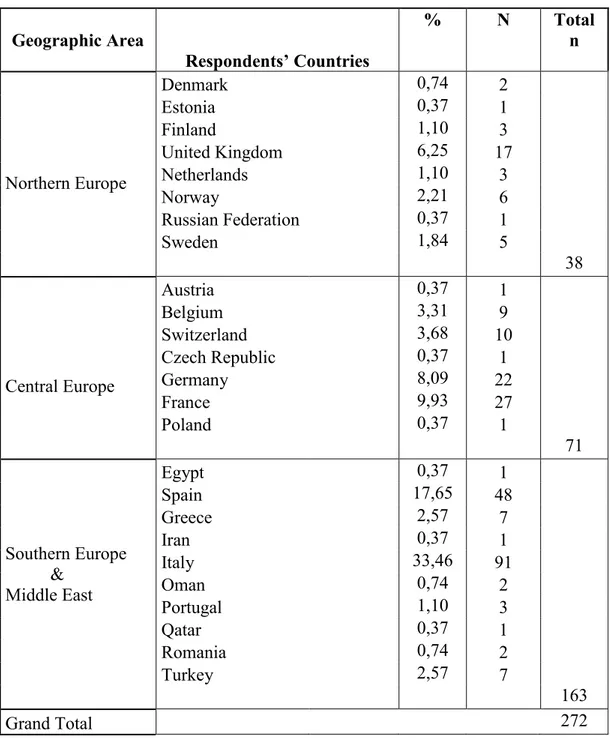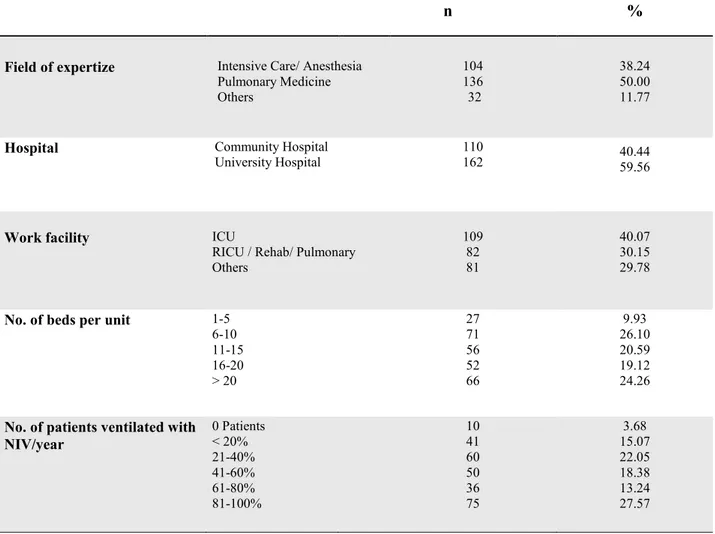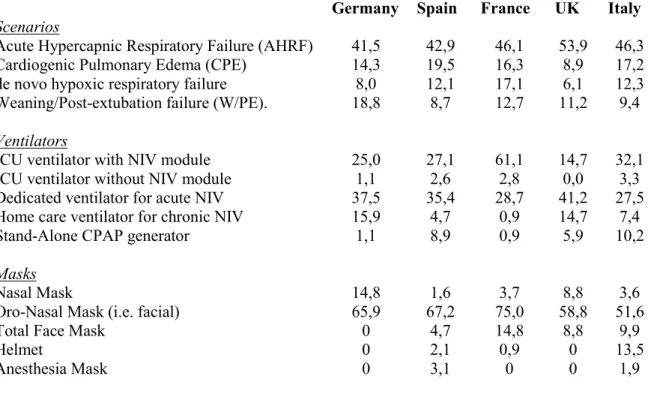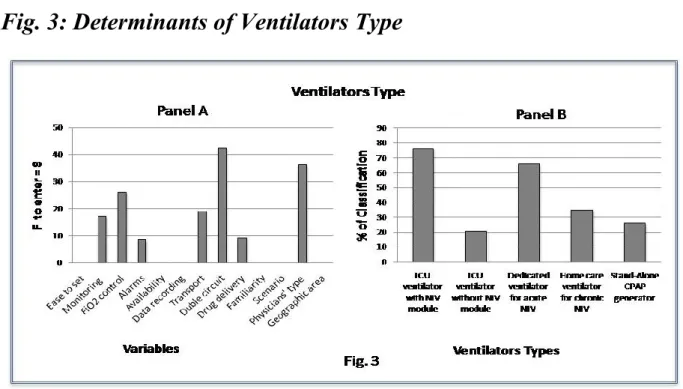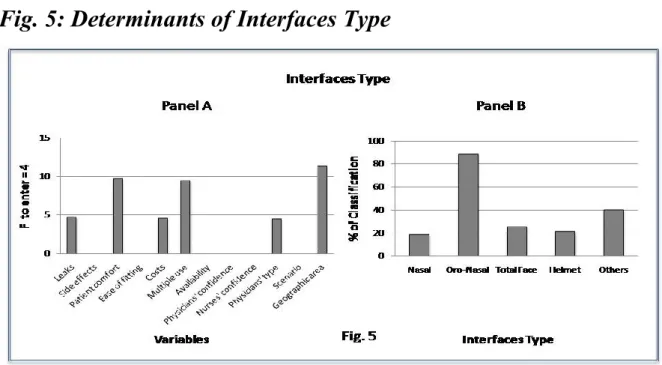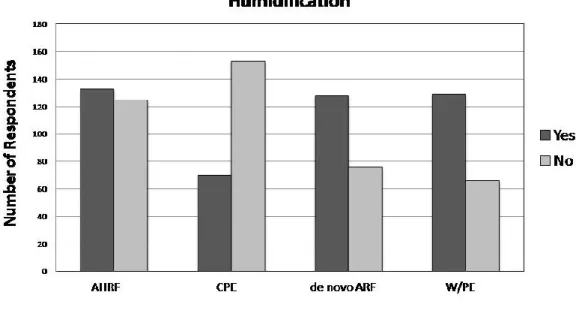1
UNIVERSITY OF CATANIA, SCHOOL OF MEDICINE
P
H
D P
ROGRAM IN RESPIRATORY DISEASES
XXIII Cycle
Claudia Crimi
_________________________________________________
A EUROPEAN SURVEY OF NONINVASIVE
VENTILATION PRACTICES
____________
PhD Thesis
____________
Coordinator:
Prof. Carlo Vancheri
2
Table of Content
1. INTRODUCTION ... PAG 3 2. METHODS ... PAG 5 3. RESULTS ... PAG 13 4. DISCUSSION ... PAG 18 5. CONCLUSION ... PAG 27 6. TABLE AND FIGURES ... PAG 29 7. REFERENCES ... PAG 393
4
Non-Invasive Ventilation (NIV) is well recognized as a valid strategy to avoid endotracheal intubation and its complications in selected patients with respiratory failure [1, 2].
Over the past two decades, the use of noninvasive positive-pressure ventilation and noninvasive continuous positive airway positive-pressure by mask has increased substantially for acutely ill patients.
Initial case series and uncontrolled cohort studies that suggested benefit in selected patients led to many randomized controlled trials (RCTs). Both methods of ventilation have been used in the setting of acute respiratory failure to avoid endotracheal intubation in different patient populations and settings, with variable success.
In addition, noninvasive positive-pressure ventilation has been used to facilitate early liberation from conventional mechanical ventilation and to prevent reintubation.
Growing evidence indicates that NIV is the standard first-line therapy for cardiogenic pulmonary edema (CPE) and chronic obstructive pulmonary disease (COPD).
NIV is also starting to be tried out in the emergency department (ED) for other diseases, such as asthma, acute exacerbation of other types of hypercapnic failure, pneumonia, and acute respiratory distress syndrome (ARDS). Furthermore, since respiratory distress due to CPE
5
can be rapidly retrieved even with continuous positive airway pressure (CPAP), which has the great advantage of easy application, prehospital CPAP for presumed CPE is considered to be at the cutting edge of emergency medicine.
Some surveys have shown that the utilization of NIV may greatly vary depending on the geographical location and the types of environment. NIV use in the French Intensive Care Units (ICUs) increased from 16% to 24% of the total ventilated patients and from 35 to 52% of the patients starting ventilation in ICU, from 1997 to 2002 [3], while in other European and North American Countries the utilization rate is much lower [4, 5].
The low utilization rate in certain areas is related to lack of knowledge about or experience with the technique, insufficient technical equipment like specific ventilators and ad-hoc interfaces and lack of funding [4]. Despite these difficulties, NIV use has been increasing also outside the ICU setting, including high-dependency units, respiratory ward, emergency room and post-surgical recovery rooms [6-8].
Nowadays considerable technological advances were done by manufactures both in the development of new ventilatory modes and more sophisticated machines and interfaces, allowing physicians to choose the appropriate device for each patient.
6
In the present study we used an ad-hoc designed web questionnaire to assess current NIV practices in various environments in Europe and in different case-scenarios, placing emphasis on the technical aspects of NIV use.
7
8
Instrument Development and Testing
We conducted a web survey of physicians dealing with NIV at 25 European countries between January and March 2008.
A survey instrument [9] was developed to examine physicians’ knowledge, attitudes and practice about NIV use in 4 most common clinical scenarios.
We performed individual semi-structured interviews to identify content areas and items of interest, to a group of local pulmonologists and intensivists, in order to generate items and formulate questions.
A pilot testing was also performed to test content validity, reliability and relevance of the questionnaire and the ability to discriminate among respondents.
Pre-testing and pilot testing were used to improve the questionnaire wording. The questionnaire showed good internal consistency reliability with Cronbach's ≥ 0.78.
Clinical sensibility testing with personal interviews among four intensivists and four pulmonologists around Europe were conducted in order to evaluate the comprehensiveness, clarity and validity. The
9
questionnaire had adequate content validity showing a Content Validity Index ≥ 0.78.
We developed survey questions with a structured response format, using multiple choice responses option and Likert scales and then we created a user-friendly web-based questionnaire.
Questions were presented on a series of linked pages (multiple-item screens) with progress indicators. Radio buttons and list box were used allowing users to choose only one option from a predefined set of alternatives.
Questions were ordered on the basis of content: a) broad questions on respondents’ demographics and professional data; b) specific questions, addressing physician experience and confidence with NIV and c) scenario-based questions, asking physicians about their own clinical experience with NIV in 4 common clinical case scenarios:1) Acute Hypercapnic Respiratory Failure (AHRF), 2) Cardiogenic Pulmonary Edema (CPE), 3) ALI/ARDS/CAP/post-surgical (de novo respiratory failure), 4) Weaning/Post-extubation failure (W/PE).
Survey Administration
The survey was sent to all members of the European Respiratory Society Assembly of Critical Care, members of the European Society of
10
Intensive Care Medicine Group of Acute Respiratory Failure and physicians working in the Emergency Department (ED), known to be involved in NIV practice or to have published on the topic. Few members (n=12) of extra-European Countries (mainly from Middle-East), were also included in the survey because members of one of the two Societies.
Respondents were linked to a specific scenario-based section where they were asked to select the type of ventilator and interface they principally choose using NIV.
We identified some variables considered to be potentially important in the decision to choose a specific type of ventilator or interface for each clinical scenario and asked respondents to rate their importance in the decision making process using a 5-point Likert scale ranging from 1 (irrelevant) to 5 (very important).
Each physician was provided with a unique username and password that gave access to a secure internet-based questionnaire.
We emailed the final surveys to a total of 530 physicians. Reminders were sent to clinicians who did not respond to the first mailing within 8 weeks.
The survey was approved by the Institutional Review Board of the Fondazione Salvatore Maugeri.
11
Statistical Analysis
Countries were divided into three geographic areas prior to data analysis: Northern Europe, Central Europe, Southern Europe and Middle-East (Table 1).
Descriptive statistics (means, medians and proportions) was used to report responses to survey items and to summarize respondents’ characteristics.
To evaluate the variability in NIV utilization among different clinical scenarios and physician groups (Intensivists vs. Pulmonologists vs. Others) we used the Kruskal-Wallis test for non parametric data. Cochran’s Q-test was used to test for the variability in the attitude toward the use of different ventilators’ and masks’ types for each scenario.
Multivariate analysis
We conducted multivariate analysis using “supervised learning” technique that allowed us to generate models, assuming a priori the presence of categories.
12
Ventilator type as category index (ICU ventilator with NIV module, ICU ventilator without NIV module, Dedicated ventilator for acute NIV, Home care ventilator for chronic NIV, Stand Alone CPAP generator) and the reasons of ventilator choice, plus the Geographic area, physicians’ type and clinical scenarios.
In a similar way, masks’ data were processed, generating the following model:
Mask Type as category index (Nasal, Oro-Nasal, Total Face, Helmet, Others) and the reasons of interface choice, plus the Geographic area, physicians’ type and clinical scenarios.
Each model was processed using Stepwise Linear Discriminant Analysis (STEPLDA) to determine the variables that enhance discrimination among the respective categories.New dataset created on every STEPLDA run, contained the original category index and objects but only the most discriminant variables. K-nearest neighbor’s (KNN) algorithm was applied for each new dataset to estimate models’ accuracy and discrimination capability.
Statistical analysis was performed using SPSS version 15 (SPSS Inc. Chicago IL USA) and PARVUS 2008 [10]. A probability value of p<0.05 was considered to be statistically significant.
13
14
272 of 530 (51.3%) physicians (133 Pulmonologists, 109 Intensivists/Anesthesiologists, 30 Others) responded to the survey. Respondents’ characteristics are shown in table 1 and table 2. Scenario, ventilator and mask distribution among countries with the highest number of respondents are shown in table 3.
Rate of NIV utilization
NIV utilization rate was significantly higher for Pulmonologists (52.9% reported >20% of patients treated with NIV a year) vs. Intensivists/Anesthesiologists (34.3%) and vs. Others (12.6%), [p<0.05]. On average, physicians rated AHRF as the most common indication for the use of NIV among the scenarios.
Overall, attitudes toward the use of NIV in clinical settings differed significantly among the groups of physician respondents [Fig.1]. Pulmonologists were more likely to use NIV in the treatment of AHRF compared to Intensivists (58.9% vs. 35.2%), conversely these latter were more likely to use NIV in patients with CPE (18.7% vs. 7.2%), de novo respiratory failure (19.1% vs. 6.2%) and in W/PE (14.4% vs. 8.5%), [p<0.05].
15
Ventilator choice
Fig. 2a shows ventilator distribution among the 4 clinical scenarios.
AHRF patients, physicians were more likely to use NIV dedicated ventilator, compared to ICU ventilator with NIV module, and the others [p<0.01].
In CPE, NIV dedicated ventilator and ICU ventilator with NIV module were mostly used, with stand-alone CPAP generator employed by ~23% of the respondents (NS).
In de novo respiratory failure and W/PE scenarios we found similar distribution rates: ICU ventilator with NIV module significantly more used than NIV dedicated ventilator (p=0.02 and 0.01 for de-novo respiratory failure and W/PE, respectively).
Considering the distribution of ventilators based on physician qualification and regardless of the scenario, the most frequent ventilator type used during NIV by the Anesthesiologists/Intensivists was ICU ventilator with NIV module conversely, NIV dedicated ventilator was the preferred choice of pulmonologists [Fig. 2b].
Reasons for choosing a specific ventilator, as assessed using the discriminant analysis, are shown on Fig. 3a. In decreasing order of power, double circuit, FiO2 control, easy of transport, monitoring
16
capability, possibility of setting alarms and of drug delivery, were the significant parameters which provided distinction among the ventilator types.
The ability of each parameter in discriminating among ventilators was investigated using a k-nearest neighbour (kNN) classifier: the above mentioned parameters together with physicians’ type (F= 36.3) had a kNN of 76.4% for ICU ventilator with NIV module and 65.8% for NIV dedicated ventilator [Fig. 3b].
Interface choice
Interface preferences were not influenced by clinical scenarios and the oronasal-mask was overall the most used (p<0.01), [Fig. 4a] irrespectively of the type of physicians [Fig. 4b].
Geographic area (i.e. greater use of the helmet and total face in Southern Europe), patients comfort, multiple patient use, leaks, costs were factors significantly associated with mask’s choice [Fig. 5a].
The ability of each parameter in discriminating among interfaces, investigated using a k-nearest neighbour (kNN) classifier showed that the above mentioned parameters together with the physicians’ type (F=4.5) had a kNN of 88.9% for the oro-nasal mask [Fig. 5b].
17
Humidification
As shown on Fig. 6 the humidification use, assessed by a dichotomy response (yes/no) was >50% in all the clinical scenarios except for CPE.
18
19
Despite the increased amount of scientific evidences in the last 10-15 years, the real life application of NIV is only partially known and an international survey conducted in 2004 demonstrated that the actual use of NIV in the ICUs around the world is ~12% of the ventilated patients [5]. On the other side 5 years before the same Authors showed a much lower rate of NIV utilization in the same units, so that it was speculated that the increasing scientific evidences, may have influenced this trend.
Geographical differences were also highlighted: the rate of NIV utilization in certain European countries is quite high [3], while in others [11, 12] and in North America [4], NIV use rate is lower.
From 1997 to 2002 an increased NIV use was observed in French ICUs: from 16% to 24% of total ventilated patients and from 35 to 52% of patients starting ventilation in ICU [3], while in 1997, 48% of the respiratory wards in UK were using NIV for the treatment of AHRF [12].
In German ICUs NIV use is <10% in most of the units [11], while in the New England acute care hospitals, the real life utilization of NIV is around 20% [4]. Very recently it has also been shown that in the ED across the US the perceived use of NIV is < 30% considering the most “popular” indications (AHRF, CPE and Asthma) [13]. Most of these data were collected in specific surveys concentrated in a single
20
country/geographical area and on a single environment. Indeed with very few exceptions [4] they were not focused on technological issues, such as the ventilator and interfaces, which have been very often considered as one of the barriers to limit the use of NIV in real life.
In this large European web- based survey we have demonstrated that the use of NIV, as perceived by the physicians, is relatively homogeneously spread in the different geographical regions and high especially among pulmonologists and that the indications for its application are those recommended by the literature. The oro-nasal interfaces are thought to be by far the most used interfaces for all the clinical scenarios, while dedicated NIV ventilators or ICU ventilators with NIV module are largely utilized.
Use of NIV and its indications
Overall we have found that the perceived NIV use among pulmonologists is higher in Europe than among intensivists and emergency medicine physicians. It has to be noted that contrariwise to North America, pulmonologists are working very rarely in ICU and their main work facilities are either the pulmonary ward or the so-called Respiratory Intensive Care Unit (RICU), which act as a step-up unit for the ward or step down unit for the ICU. Therefore the supposed larger
21
use of NIV among pulmonologists may depend on several reasons, including different timing of application (i.e. preventive vs. alternative to intubation use) [14], patients’ and diseases’ severity, and the fact that many patients admitted to the ER or ICU are already intubated.
In keeping with the scientific evidences, on average the clinicians reported AHRF as the most common indication, following by CPE, de-novo respiratory failure and W/PE. Not surprisingly pulmonologists were more likely to apply NIV in AHRF patients than intensivists and the latter used it more often on hypoxemic patients and during weaning, probably because those patients require closer monitoring and higher Nurse to Patient ratio, and therefore need to stay in ICU.
Use and reason for choosing a particular ventilator
ICU ventilators without NIV module and home care ventilators were perceived to be very seldom used during an episode of acute respiratory failure. Mostly used machines were the dedicated NIV platforms especially for AHRF, and therefore mainly by pulmonologists while ICU ventilators with the NIV module for other forms of acute hypoxia, mainly by the intensivists.
The reason for choosing a ventilator with a module able to compensate for air leaks is self-explanatory being NIV a semi-open
22
ventilatory circuit, where avoidance of air leaks is almost impossible and therefore by far the most reported side effect [1, 2]. Despite in vitro it was demonstrated a large variation in the ability for compensating leaks among the most common ICU ventilators [15, 16], there is agreement that the use of NIV machines’ software is able to perform much better using the same settings than without it.
For CPE >20% of the respondents reported a preference of using CPAP, probably for its ease of use outside the protected environment and the possible short period of ventilation in this clinical situation. The problem of CO2 rebreathing has always been a major clinicians’ concern, especially among those dealing with hypercapnic respiratory failure, so that, the use of a double tubings ventilator was a preferred option, despite several studies showing that the “intentional leak” single circuit, when appropriately set, is able to minimize but not eliminate rebreathing [17, 18].
The possibility of applying a fixed and known FiO2 has also been considered a safe feature especially in those patients with de-novo hypoxia. The measure of a correct FiO2/PaO2 ratio is also important as a monitoring measure, since it may better drive clinicians’ decisions, than when using a low flow system. In particular it has been shown that the FiO2 actually delivered using a low flow oxygen port in the circuit
23
varies dramatically according to the ventilator settings, the amount of oxygen and the position of the probe, and that it may be not always deliver the same value [19].
The possibility of having a good monitoring system, together with more sophisticated alarms, highlights the problem of assessing directly patient-ventilator synchronies, especially during the first few phases of NIV. The presence of patient-ventilator asynchronies, especially in intubated patients, is associated with a prolonged duration of ventilation and higher incidence of tracheotomy [20].
When NIV or any other form of mechanical ventilation is applied, medical therapy should be continued, therefore respondents considered the possibility of bronchodilators’ delivery during NIV as important This holds particularly true in COPD patients where administration of bronchodilators and steroids is a paramount intervention in an attempt to reduce elastic and resistive loads . Few studies assessed the possibility of delivering this therapy during NIV, and in vivo mainly with the double tubing system, using the same “model” adopted during invasive ventilation [21, 22].
24
Use and reason for choosing a particular interface
There was almost unanimous agreement about the perceived use of the oro-nasal masks in every clinical scenario, irrespective of the type of physician involved. This is in keeping with the Literature where the large majority of the studies employed this type of interface [23]. It is likely that the other masks were considered mainly as a part of the “rotation strategy” when the patient is poorly tolerant to the full-face or to avoid some side-effects. In certain European Countries (i.e. Italy), the helmet has been extensively used especially in ICU, mainly for hypoxic respiratory failure and CPE [24], but overall in Europe the percentage of use was relatively small.
The main reasons for choosing a particular interface were the patient’s comfort, the avoidance of leaks and the costs. The tolerance of patients to NIV it is strongly related to the presence of air leaks, since it has been demonstrated that increasing the leaks is associated with a worst compliance [25] andthe full-face mask is in this respect much more efficient than the nasal mask [26]. Costs reduction is a major goal for clinicians; therefore it is not surprising that the economical issue was pointed out as one of the main determinants of the choice.
Nowadays, improvements in technology and materials used to assemble the interfaces allow us to use rather inexpensive masks in most
25
of the patients, despite the most severe ones, might need more sophisticated and costly interfaces.
Humidification
Humidification and warming of the inspired gas by specific devices may be needed to prevent the effects due to cool, dry gases on the trachea-bronchial epithelium during NIV [27, 28];it is therefore rather surprising that humidification is employed in a relatively small percentage of patients (~55%).The dichotomy nature of the question (yes/no), did not allow us to discriminate about the use of the Heated Humidifiers (HH) vs. Heat and Moisture Exchangers (HME).
Strengths and limitations
The questionnaire was based, as in most of the medical surveys, on the perception of NIV use rather than on collection of data, that may have given a more detailed and real rate of NIV use in Europe.
Another limitation is the selection of respondents, mainly based on their membership to a particular group or assembly of an international Society. This may have biased the results, since the members of a scientific Society may be more exposed and eventually prone to apply the innovations in medicine [29] as NIV may be considered. In keeping
26
with the previous point, the majority of the respondents were from a University-hospital, despite the number of non-University hospitals in Europe is higher. Therefore the data obtained in the present survey may be not generalized.
Major strengths of this study are the relatively high rate of response for a web-survey, and the possibility of having a complete response to all the questions by every respondent, since otherwise the questionnaire could not be submitted. This was not the case for other surveys where partially completed questionnaire might affect the response rate. Indeed only one respondent per centre was allowed, avoiding repetitive answers from the same unit.
27
28
This study indicates that in Europe the perceived use of NIV is relatively high, especially among pulmonologists and less frequent among the intensivists, probably because of the different timing of NIV application.
The indications of the perceived use are according to those suggested by the international guidelines.
Ventilators with NIV platform are mainly used in AHRF due to COPD exacerbations, while ICU ventilators with the NIV module are preferentially employed in de-novo hypoxic respiratory failure.
Overall the full-face interfaces are those of choice irrespective of the clinical scenarios.
29
30
Table 1. Respondents’ Geographic area*
Geographic Area Respondents’ Countries % N Total n Northern Europe Denmark 0,74 2 Estonia 0,37 1 Finland 1,10 3 United Kingdom 6,25 17 Netherlands 1,10 3 Norway 2,21 6 Russian Federation 0,37 1 Sweden 1,84 5 38 Central Europe Austria 0,37 1 Belgium 3,31 9 Switzerland 3,68 10 Czech Republic 0,37 1 Germany 8,09 22 France 9,93 27 Poland 0,37 1 71 Southern Europe & Middle East Egypt 0,37 1 Spain 17,65 48 Greece 2,57 7 Iran 0,37 1 Italy 33,46 91 Oman 0,74 2 Portugal 1,10 3 Qatar 0,37 1 Romania 0,74 2 Turkey 2,57 7 163 Grand Total 272
31
Table 2. Respondents’ Characteristics’*
*Data are expressed as a percentage of respondent’s
n %
Field of expertize Intensive Care/ Anesthesia Pulmonary Medicine Others 104 136 32 38.24 50.00 11.77
Hospital Community Hospital
University Hospital 110 162 40.44 59.56
Work facility ICU
RICU / Rehab/ Pulmonary Others 109 82 81 40.07 30.15 29.78
No. of beds per unit 1-5 6-10 11-15 16-20 > 20 27 71 56 52 66 9.93 26.10 20.59 19.12 24.26
No. of patients ventilated with NIV/year 0 Patients < 20% 21-40% 41-60% 61-80% 81-100% 10 41 60 50 36 75 3.68 15.07 22.05 18.38 13.24 27.57
32
Table 3. Scenario, ventilator and mask distribution among
countries with the highest number of respondents*
Germany Spain France UK Italy
Scenarios
Acute Hypercapnic Respiratory Failure (AHRF) 41,5 42,9 46,1 53,9 46,3 Cardiogenic Pulmonary Edema (CPE) 14,3 19,5 16,3 8,9 17,2 de novo hypoxic respiratory failure 8,0 12,1 17,1 6,1 12,3 Weaning/Post-extubation failure (W/PE). 18,8 8,7 12,7 11,2 9,4
Ventilators
ICU ventilator with NIV module 25,0 27,1 61,1 14,7 32,1 ICU ventilator without NIV module 1,1 2,6 2,8 0,0 3,3 Dedicated ventilator for acute NIV 37,5 35,4 28,7 41,2 27,5 Home care ventilator for chronic NIV 15,9 4,7 0,9 14,7 7,4 Stand-Alone CPAP generator 1,1 8,9 0,9 5,9 10,2
Masks
Nasal Mask 14,8 1,6 3,7 8,8 3,6 Oro-Nasal Mask (i.e. facial) 65,9 67,2 75,0 58,8 51,6 Total Face Mask 0 4,7 14,8 8,8 9,9 Helmet 0 2,1 0,9 0 13,5 Anesthesia Mask 0 3,1 0 0 1,9
33
Fig.1: Differences in NIV attitudes among groups of
physicians’ respondents.
Data are expressed as percentage of all respondents. *p values were significant for each scenario, between Intensivists/Anesthesiologists and Pulmonologists. AHRF=Acute Hypercapnic Respiratory Failure; CPE=Cardiogenic Pulmonary Edema (CPE); de novo ARF=de novo Acute Respiratory Failure; W/PE=Weaning/Post-extubation failure.
34
Fig.2:
2a) Ventilators’ distribution for each clinical case scenario;
2b) Ventilators’ distribution for each physician’s type.
Data are expressed as percentage of all respondents. AHRF=Acute Hypercapnic Respiratory Failure; CPE=Cardiogenic Pulmonary Edema (CPE); de novo ARF=de novo Acute Respiratory Failure; W/PE=Weaning/Post-extubation failure.
35
Fig. 3: Determinants of Ventilators Type
Panel A: factors that were identified as determinants in the decision to choose a specific ventilator type by multivariate analysis, using Stepwise Linear Discriminant Analysis (STEPLDA). The F to enter value
indicates Likert scale variables’ statistical significance in the
discrimination among ventilators’ groups/types. F to enter is a measure of the extent to which a variable makes a unique contribution to the prediction of group membership.
Panel B: the determinants factors identified by the multivariate analysis cross-validated by the K-nearest neighbor’s (KNN) algorithm, that test the accuracy (or percentage of correctly classified cases) of the
36
Fig.4:
4a) Interface distribution for each clinical case scenario;
4b) Interface distribution for each physician’s type.
37
Fig. 5: Determinants of Interfaces Type
Panel A: factors that were identified as determinants in the decision to choose a specific ventilator type by multivariate analysis, using the Stepwise Linear Discriminant Analysis (STEPLDA). The F to enter value indicates variables’ statistical significance in the discrimination between masks’ groups/types. F to enter is a measure of the extent to which a variable makes a unique contribution to the prediction of group membership.
Panel B: the determinants factors identified by the multivariate analysis cross-validated by the K-nearest neighbor’s (KNN) algorithm, that test the accuracy (or percentage of correctly classified cases) of the
38
Fig. 6: Humidification use among the different clinical
scenarios
39
40 1. Ambrosino N, Vagheggini G. Noninvasive positive pressure ventilation in the acute care setting: where are we? Eur Respir J 2008: 31(4): 874-886.
2. Nava S, Hill N. Non-invasive ventilation in acute respiratory failure. Lancet 2009: 374: 250-259.
3. Demoule A, Girou E, Richard JC, Taille S, Brochard L. Increased use of noninvasive ventilation in French intensive care units. Intensive Care Med 2006: 32(11): 1747-1755.
4. Maheshwari V, Paioli D, Rothaar R, Hill NS. Utilization of noninvasive ventilation in acute care hospitals: a regional survey. Chest 2006: 129(5): 1226-1233. 5. Esteban A, Ferguson ND, Meade MO, Frutos-Vivar F, Apezteguia C,
Brochard L, Raymondos K, Nin N, Hurtado J, Tomicic V, Gonzalez M, Elizalde J, Nightingale P, Abroug F, Pelosi P, Arabi Y, Moreno R, Jibaja M, D'Empaire G, Sandi F, Matamis D, Montanez AM, Anzueto A. Evolution of mechanical ventilation in response to clinical research. Am J Respir Crit Care Med 2008: 177(2): 170-177. 6. Nava S, Sturani C, Hartl S, Magni G, Ciontu M, Corrado A, Simonds A. End-of-life decision-making in respiratory intermediate care units: a European survey.
Eur Respir J 2007: 30(1): 156-164.
7. Plant PK, Owen JL, Elliott MW. Early use of non-invasive ventilation for acute exacerbations of chronic obstructive pulmonary disease on general respiratory wards: a multicentre randomised controlled trial. Lancet 2000: 355(9219): 1931-1935.
8. Poponick JM, Renston JP, Bennett RP, Emerman CL. Use of a ventilatory support system (BiPAP) for acute respiratory failure in the emergency department.
41 9. Burns KE, Duffett M, Kho ME, Meade MO, Adhikari NK, Sinuff T, Cook DJ. A guide for the design and conduct of self-administered surveys of clinicians.
Cmaj 2008: 179(3): 245-252.
10. Forina M. http://www.parvus.unige.it. 2008.
11. Kumle B, Haisch G, Suttner SW, Piper SN, Maleck W, Boldt J. [Current status of non-invasive ventilation in German ICU's -- a postal survey]. Anasthesiol
Intensivmed Notfallmed Schmerzther 2003: 38(1): 32-37.
12. Doherty MJ, Greenstone MA. Survey of non-invasive ventilation (NIPPV) in patients with acute exacerbations of chronic obstructive pulmonary disease (COPD) in the UK. Thorax 1998: 53(10): 863-866.
13. Hess DR, Pang JM, Camargo CA, Jr. A survey of the use of noninvasive ventilation in academic emergency departments in the United States. Respir Care 2009: 54(10): 1306-1312.
14. Nava S, Navalesi P, Conti G. Time of non-invasive ventilation. Intensive
Care Med 2006: 32(3): 361-370.
15. Vignaux L, Tassaux D, Jolliet P. Performance of noninvasive ventilation modes on ICU ventilators during pressure support: a bench model study. Intensive
Care Med 2007: 33(8): 1444-1451.
16. Ferreira JC, Chipman DW, Hill NS, Kacmarek RM. Bilevel vs ICU
ventilators providing noninvasive ventilation: effect of system leaks: a COPD lung model comparison. Chest 2009: 136(2): 448-456.
17. Lofaso F, Brochard L, Touchard D, Hang T, Harf A, Isabey D. Evaluation of carbon dioxide rebreathing during pressure support ventilation with airway
42 18. Ferguson GT, Gilmartin M. CO2 rebreathing during BiPAP ventilatory
assistance. Am J Respir Crit Care Med 1995: 151(4): 1126-1135.
19. Thys F, Liistro G, Dozin O, Marion E, Rodenstein DO. Determinants of Fi,O2 with oxygen supplementation during noninvasive two-level positive pressure ventilation. Eur Respir J 2002: 19(4): 653-657.
20. Thille AW, Rodriguez P, Cabello B, Lellouche F, Brochard L. Patient-ventilator asynchrony during assisted mechanical ventilation. Intensive Care Med 2006: 32(10): 1515-1522.
21. Nava S, Karakurt S, Rampulla C, Braschi A, Fanfulla F. Salbutamol delivery during non-invasive mechanical ventilation in patients with chronic obstructive pulmonary disease: a randomized, controlled study. Intensive Care Med 2001: 27(10): 1627-1635.
22. Pollack CV, Jr., Fleisch KB, Dowsey K. Treatment of acute bronchospasm with beta-adrenergic agonist aerosols delivered by a nasal bilevel positive airway pressure circuit. Ann Emerg Med 1995: 26(5): 552-557.
23. Kwok H, McCormack J, Cece R, Houtchens J, Hill NS. Controlled trial of oronasal versus nasal mask ventilation in the treatment of acute respiratory failure.
Crit Care Med 2003: 31(2): 468-473.
24. Chiumello D, Pelosi P, Carlesso E, Severgnini P, Aspesi M, Gamberoni C, Antonelli M, Conti G, Chiaranda M, Gattinoni L. Noninvasive positive pressure ventilation delivered by helmet vs. standard face mask. Intensive Care Med 2003: 29(10): 1671-1679.
43 25. Prinianakis G, Delmastro M, Carlucci A, Ceriana P, Nava S. Effect of varying the pressurisation rate during noninvasive pressure support ventilation. Eur Respir J 2004: 23(2): 314-320.
26. Girault C, Briel A, Benichou J, Hellot MF, Dachraoui F, Tamion F,
Bonmarchand G. Interface strategy during noninvasive positive pressure ventilation for hypercapnic acute respiratory failure. Crit Care Med 2009: 37(1): 124-131. 27. Richards GN, Cistulli PA, Ungar RG, Berthon-Jones M, Sullivan CE. Mouth leak with nasal continuous positive airway pressure increases nasal airway resistance.
Am J Respir Crit Care Med 1996: 154(1): 182-186.
28. Hayes MJ, McGregor FB, Roberts DN, Schroter RC, Pride NB. Continuous nasal positive airway pressure with a mouth leak: effect on nasal mucosal blood flux and nasal geometry. Thorax 1995: 50(11): 1179-1182.
29. Berwick DM. Disseminating innovations in health care. JAMA 2003: 289(15): 1969-1975.
